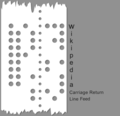The Baudot code (French pronunciation: [bodo]) is an early character encoding for telegraphy invented by Émile Baudot in the 1870s. It was the predecessor...
57 KB (2,988 words) - 02:07, 6 July 2025
communication Baudot code, was one of the pioneers of telecommunications. He invented a multiplexed printing telegraph system that used his code and allowed...
14 KB (1,738 words) - 22:25, 28 December 2024
telegraph engineer, inventor of the Baudot code Anatole de Baudot (1834-1915), French architect Technology: Baudot code, a way to encode characters for sending...
364 bytes (79 words) - 02:57, 12 March 2022
The first of these was the Baudot code, a five-bit code. Baudot has only enough code points to print in upper case. Later codes had more bits (ASCII has...
63 KB (6,313 words) - 10:04, 23 October 2024
Escape sequence (redirect from Escape code)
such as ASCII escape. Escape sequences date back at least to the 1874 Baudot code. A common use of an escape sequence is to remove control characters from...
13 KB (1,440 words) - 08:22, 6 July 2025
MCM was designed around the five-bit Baudot code established by the older TTY machines instead of the ASCII code used by computers. The MCM was an instant...
25 KB (2,904 words) - 10:36, 20 May 2025
one dimension. When the French engineer Émile Baudot changed from using a 6-unit (6-bit) code to 5-unit code for his printing telegraph system, in 1875 or...
181 KB (15,906 words) - 03:08, 12 July 2025
replaced skilled operators versed in Morse code with typists and machines communicating faster via Baudot code. With the development of early computers...
54 KB (6,709 words) - 13:39, 12 April 2025
Control character (redirect from Control code)
the 1870 Baudot code: NUL and DEL. The 1901 Murray code added the carriage return (CR) and line feed (LF), and other versions of the Baudot code included...
26 KB (3,644 words) - 20:02, 13 June 2025
Character encoding (redirect from Character code)
but the path of code development to the present is fairly well known. The Baudot code, a five-bit encoding, was created by Émile Baudot in 1870, patented...
31 KB (3,793 words) - 16:38, 7 July 2025
punched tape transmission. These systems led to new telegraph codes, starting with the Baudot code. However, telegrams were never able to compete with the letter...
79 KB (9,881 words) - 21:05, 21 June 2025
the Q code is reserved for international radiocommunications and non-geographical special use. In Russia, the Latin letter X, or its Morse/Baudot Cyrillic...
37 KB (1,152 words) - 17:59, 10 July 2025
character codes generally succeeded the five-bit Baudot code and preceded seven-bit ASCII. Six-bit codes could encode more than 64 characters by the use...
44 KB (1,416 words) - 21:09, 27 June 2025
by the label "BEL". They have been used since 1870 (initially in the Baudot code). To maintain backward compatibility, video display terminals (VDTs)...
5 KB (525 words) - 11:22, 1 June 2025
album's cover art combines colours and blocks to represent the title in Baudot code. The album contains twelve tracks, divided into respective halves labeled...
113 KB (8,676 words) - 06:31, 13 July 2025
ASCII (redirect from ASCII code)
(1963), more than 64 codes were required for ASCII. ITA2 was in turn based on Baudot code, the 5-bit telegraph code Émile Baudot invented in 1870 and...
108 KB (8,024 words) - 18:55, 10 July 2025
Standard five-bit standard codes are: International Telegraph Alphabet No. 1 (ITA1) – Also commonly referred to as Baudot code International Telegraph Alphabet...
7 KB (894 words) - 05:03, 22 April 2024
A companion Teletype Model 32 used the older, established five-bit Baudot code. Because of its low price and ASCII compatibility, the Model 33 was widely...
28 KB (3,320 words) - 14:42, 30 June 2025
used for now obsolete systems such as the six-bit character code, the five-bit Baudot code and even 4-bit systems (with only 16 possible values). The more...
15 KB (1,845 words) - 14:02, 6 July 2025
in teletypewriter operation. Mechanical teleprinters using 5-bit codes (see Baudot code) typically used a stop period of 1.5 bit times. Very early electromechanical...
7 KB (801 words) - 18:29, 6 May 2025
read Italian language, by ISO 639-2 language code International Telegraph Alphabet, also known as Baudot code Independent Television Authority, the regulator...
4 KB (494 words) - 17:57, 7 February 2025
the Morkrum Printing Telegraph Blue and Green-Code printers, and was modeled after the European Baudot Telegraph System printer. The Model 11 was a Tape...
33 KB (4,239 words) - 01:09, 31 January 2025
complexity to "filter out" spurious additional CR signals. As early as 1901, Baudot code contained separate carriage return and line feed characters. Many computer...
6 KB (706 words) - 01:15, 14 May 2025
used in different contexts. Historically, Baudot code could be considered a modified (stateful) base32 code. Base32 is often used to represent byte strings...
23 KB (2,197 words) - 21:30, 27 May 2025
Baudot, which dates back to the 19th century and had five holes. The Baudot code was superseded by modified five-hole codes such as the Murray code (which...
29 KB (3,411 words) - 01:00, 19 April 2025
representation of a numeric code that identifies the object to which it is attached Baudot code, used in telegraphy Diagnosis code, used to translate medical...
6 KB (763 words) - 17:32, 1 July 2025
Offset binary (redirect from Diamond code (coding theory))
The 5-bit Baudot code used in early synchronous multiplexing telegraphs can be seen as an offset-1 (excess-1) reflected binary (Gray) code. One historically...
23 KB (1,638 words) - 16:21, 23 June 2025
second are equivalent. The baud unit is named after Émile Baudot, the inventor of the Baudot code for telegraphy, and is represented according to the rules...
7 KB (938 words) - 14:32, 16 June 2025
accepted around the world. The next improvement was the Baudot code of 1874. French engineer Émile Baudot patented a printing telegraph in which the signals...
79 KB (9,376 words) - 00:24, 19 June 2025
character as five parallel bits on five lines, typically encoded in the Baudot code or something similar. The T52 had ten pinwheels, which were stepped in...
7 KB (920 words) - 14:16, 11 May 2025















